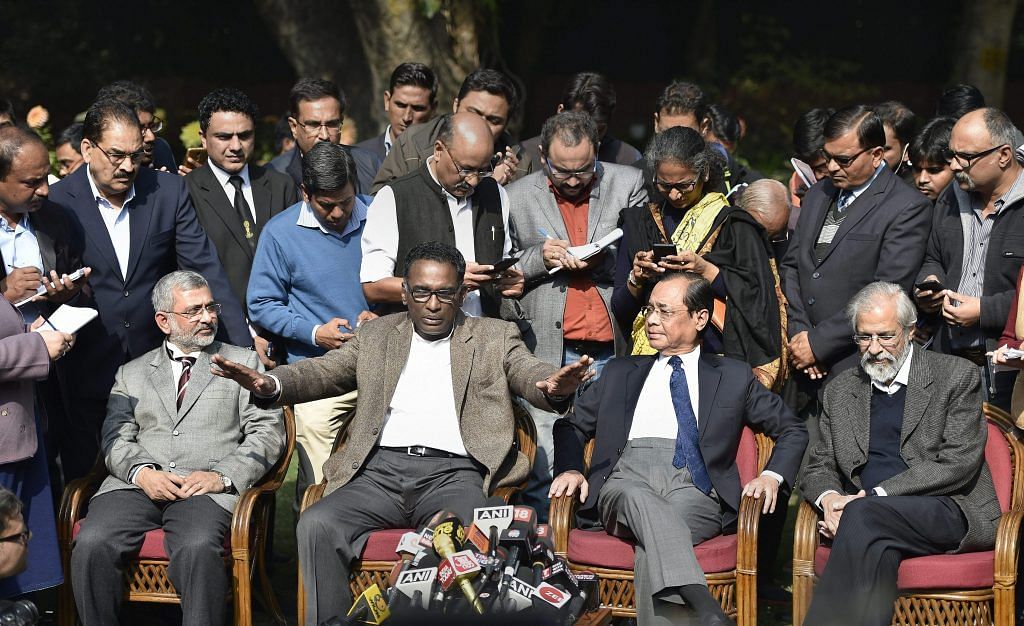As one controversy after another has shown, there is no longer much credibility for the judiciary to lose.
India is now in the midst of a full-blown constitutional crisis. The press conference by four senior judges of the Supreme Court is an alarming event. It is hard to imagine a moment since the Emergency when the Court’s institutional position was in such serious question.
The catalyst for the current episode is the allocation of cases by the Chief Justice. The Supreme Court does not sit en banc. As a result, it rests on institutional norms to ensure that justice does not depend on the courtroom where one’s case manages to appear. These norms, four senior judges have now alleged, have been jettisoned by the current Chief Justice. Practices that ensure fairness in justice-delivery have, it is suggested, all but broken down.
Some will claim that the press conference has damaged the Supreme Court’s institutional credibility. This claim confuses cause with effect. The press conference is simply the consequence of a crisis that has slowly seeped into the judiciary and, as one controversy after another has shown, there is no longer much credibility to lose. As in the case of the Emergency era, the problems are deeper than one mere incident – the crisis exists at both the level of legal doctrine and at the level of administrative governance.
At the level of legal doctrine, the past few years have witnessed the judiciary’s position being undermined in three ways. First, it has openly evaded contentious legal matters, from demonetisation to Aadhaar, such that facts have often made the legal challenge infructuous. Judicial avoidance has become the new mode of judicial review. On questions where the stake has been greatest, the Supreme Court’s decision has been to do nothing.
Second, its record on civil liberties has grown from bad to worse. Free speech is the starkest instance of this. Judgments such as those striking down Section 66A of the Information Technology Act are aberrations. Speech and expression have rarely been defended on principle, and a stunning practice of prohibiting the reporting of judicial matters is on the rise.
Third, the Supreme Court has been loudest in cases where it should, quite simply, say nothing, ranging from red lights on official cars to the playing of the national anthem in cinema halls. The Supreme Court’s recent reversal of the national anthem order is, of course, correct on the merits but it only shows how trivially the court regards the enterprise of judicial decision-making.
The three-fold undermining of legal doctrine is no small matter—it is an undermining of the rule of law. But it has come alongside the judiciary’s administrative inability to manage its functioning. Questions of integrity and propriety now routinely surface, without any sense that they are appropriately handled and managed. One need not even begin to say anything about other matters of serious legal reform, from pendency to judicial training.
The letter drafted by the judges is remarkable for what it does not say. One only needs to read it once to grasp the extent to which the institution has collapsed from within. That matters reached such a level of desperation that a press conference was called by four senior judges should make every constitutional functionary take notice, especially given the broad respect that the judges in question seem to enjoy.
The judiciary’s rise in the post-Emergency era was created around a narrative of comparative institutional legitimacy. In a world where public institutions fell victim to a host of ills, the judiciary sold itself as invested in the higher ideals of social justice and good governance. That story has now been shattered.
The Chief Justice’s constitution of benches has invited worry on more than one occasion, most notably in a corruption case involving a medical college, where basic norms relating to judicial recusal and conflict of interest appear to have been ignored. But the practice of bench allocation itself is only symptomatic not merely of the extraordinary power that Chief Justices have come to wield, but also of a deeper institutional failure to self-regulate. One cannot fully know how much of an impact such a press conference might have. The Chief Justice’s response will be crucial but, at the level of public credibility, one cannot help wonder whether the game is already over.
The government, for its part, has decided to say little about the current episode. The restraint that it has shown is good constitutional practice. It is also strategically wise. The failure of internal accountability within the judiciary will strengthen the case for external accountability, which will come at the cost of some degree of judicial independence. With this present incident, it will be much easier for the government to make the case for greater executive management of the judiciary. To make that possible, the government has rightly understood that it presently needs to do nothing. Why interrupt your enemies when they are busy in the task of self-destruction?
Madhav Khosla, co-editor of the Oxford Handbook of the Indian Constitution, is a Junior Fellow at the Harvard Society of Fellows. His Twitter handle is @M_Khosla
